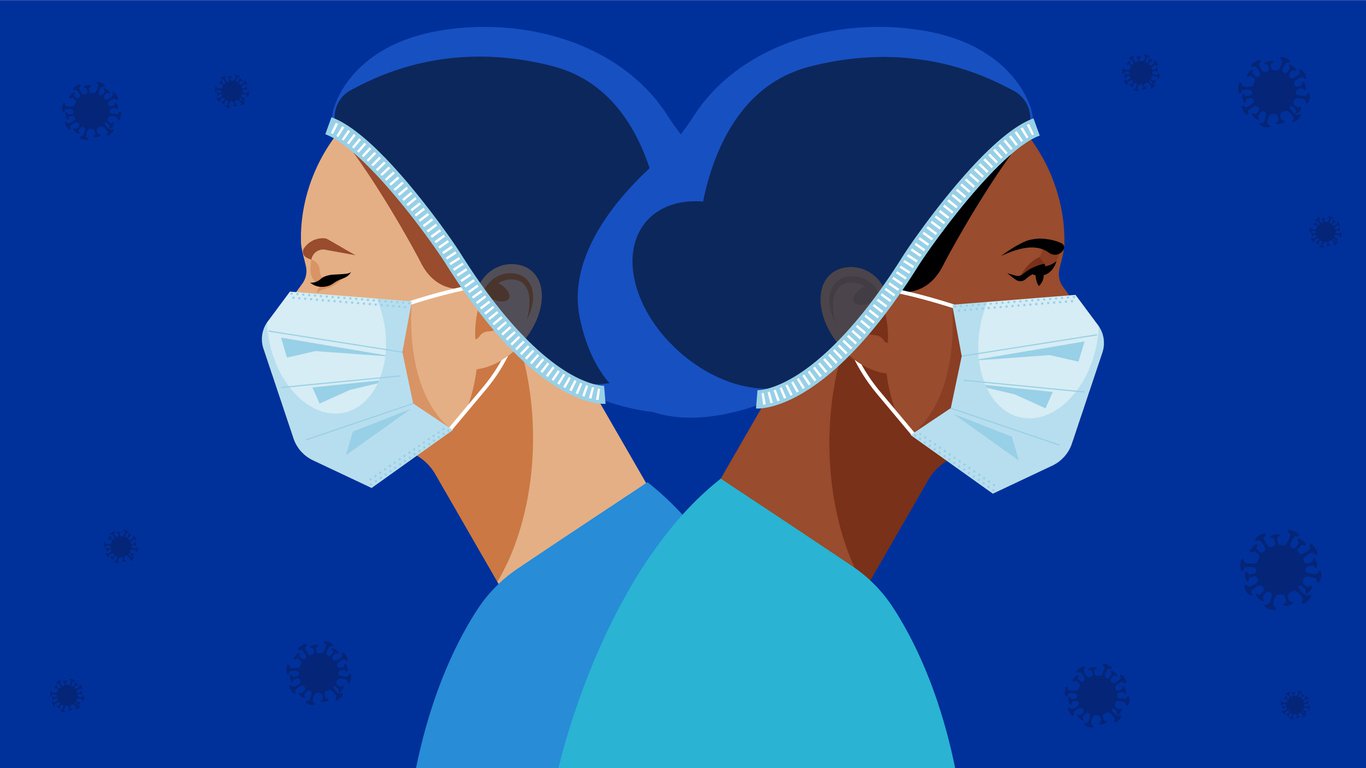Reflections from a Palliative Care Program Leader Two Years into the Pandemic

We are nearly two years into the COVID-19 pandemic, although at times it seems like it’s stretched on even longer than that. It’s taken a toll on everyone: our patients, their families, our colleagues, and ourselves. As palliative care specialists, we were trained to address the challenges that people have and we are experienced at dealing with uncertainty. But we aren’t accustomed to an ongoing crisis like COVID-19. It’s been challenging to cope with the strain that it’s placed on the health care system, and on us, too.
Palliative care teams are encountering long COVID patients and those with behavioral health issues
In 2020, we were focused on patients with acute cases of COVID. As the pandemic continued, and data evolved, more and more people needed care. Hospitals and clinics are now seeing patients with long COVID symptoms, such as debilitating fatigue, that take quite a while to recover from. Many people are coming in with post-ICU-like symptoms, reporting that they can’t focus, feel foggy, or are having a hard time synthesizing information. Some previously spent lengthy periods in the hospital before recovering enough to go home, even if they weren’t really “well” when discharged. Many are still struggling, and have diminished quality of life. Across the country, palliative care teams are asking themselves what their role is in supporting patients with long COVID.
"Across the country, palliative care teams are asking themselves what their role is in supporting patients with long COVID."
Palliative care teams are also working with more people with behavioral health issues, as the pandemic has exacerbated mental health issues for many patients. A recent study out of the Boston University School of Public Health found that depression rates accelerated during the pandemic, with one in three adults in the U.S. struggling with persistent depressive symptoms. In fact, about 4 out of every 10 adults have reported experiencing anxiety or depression, a sobering statistic when you consider that only 1 in 10 adults reported such symptoms during the six-month period of January to June 2019, according to the Kaiser Family Foundation. Palliative care teams can anticipate that they will likely encounter even more patients whose mental health was affected by the COVID pandemic.
"This work is incredibly stressful, and there are times when our clinicians will reach a breaking point."
This work is incredibly stressful, and there are times when our clinicians will reach a breaking point. They need space to decompress. And they need to be heard. At Guthrie Clinic, we’re working on that. We just launched weekly debriefing sessions for the staff of the entire hospital (from physicians and nurses, to housekeepers and maintenance workers). The sessions, led by the palliative care team and our chaplain, provide an opportunity for anyone who needs to exhale, emotionally or physically, to do so in a safe space.
We also recently reinstituted ‘The Pause’. Many of you may be familiar with the concept of this short break that provides a few moments of silence and reflection for health care team members after the death of a patient. We need this kind of pause more than ever right now. I think it brings us all back to our humanity when we stop and acknowledge that, yes, it is devastating to lose a patient, but we have done our best work. And we are part of a team that will keep doing our best. It reminds us of who we are.
Protecting the well-being of the palliative care team
As I mentioned, our health care workforce has been struggling. We know it all too well. It began long before the pandemic started, but the pandemic has just added fuel to the fire.
Consider a study to view the impact of stress and burnout, which surveyed 20,000 physicians, nurses, and other health care workers during the first wave of the pandemic. The authors found that nearly half of the sample reported burnout. Many reported feeling symptoms of depression and anxiety, too. Another 2020 study noted a sharp uptick in emotional exhaustion among staffers at one Houston hospital. And a large study conducted in the summer of 2021 for the Physicians Foundation reported that 61% of the 2,500 physicians surveyed said they’d experienced burnout often as a result of COVID. Many of them admitted to feeling withdrawn, isolated, even helpless. And experts continue to warn that something must be done.
"We as palliative care professionals, with all of our training, are not immune to stress and burnout and anxiety. We are human, too."
We as palliative care professionals, with all of our training, are not immune to stress and burnout and anxiety. We are human, too. And as palliative care leaders, we must prioritize team preservation so that we can minimize or reduce the likelihood that our palliative care team members will experience burnout. We have too much work to do!
Our team has implemented a two-week rotation, during which we joint round with the COVID Critical Care Medicine teams daily, in their unit. There is evidence that this kind of a joint rounding model leads to improved patient care. Two weeks allows the time for me or my partner, a nurse practitioner, to really get to know a patient and their family and see them through the initial period after admission. And it also gives us a break when we start feeling weighed down.
"It may seem like such a small thing, but breaking bread together gives us the chance to check in and remember the human connection that we have in common [...] it grounds us in a fundamental way."
My palliative care team also sits down and eats lunch together on a regular basis. It may seem like such a small thing, but breaking bread together gives us the chance to check in and remember the human connection that we have in common. We laugh and trade stories and remember that our lives extend beyond the hospital doors. It grounds us in a fundamental way.
You may have some ideas that will work for your own team. Don’t be afraid to explore them. Or ask your team members for ideas. They know their own needs, and they might come up with some suggestions that could benefit others, too.
How palliative care prioritizes vital connections
The heart of palliative care is focusing on the person. And what that means is that we can’t get so caught up in the technical aspects of providing care, even cutting-edge care, that we forget the person. In other words, you can’t depersonalize care at the expense of someone’s dignity.
But it’s not just the patient whose dignity matters. It also includes the patient’s family, and everyone who cares for or interacts with them. That’s what we all have to remember, all the time.
Some worry that technology in medical care contributes to depersonalization of care, and that can happen. But it doesn’t have to. At our hospital, we found ways during COVID to leverage technology to preserve and nurture the human connection. We’ve encouraged the family members of our patients to Zoom with their loved one in the hospital. “Call them while you’re eating dinner,” we tell them. “Have your dog come to the camera. Tell your family member about your day.” Even if our patient isn’t awake or conscious, we believe they’re still connecting. And to make sure that everyone could take advantage of this opportunity, I started a social media fundraiser and partnered with the local Verizon store to secure iPads for every patient room. Now, everyone can connect with their loved ones.
We’ve asked family members to help us prioritize the dignity of each patient, too. In each patient’s room, we have a “Get to Know Me” poster. We ask the family members to tell us about those small, key details that help us get to know their loved one better. You might consider adding these posters to your patient rooms, too. Then you don’t have to wonder if your patient has a nickname, a favorite movie or hobby, a beloved pet. You’ll have a better sense of what cheers them up or stresses them out, even when they can’t tell you themselves.
In other words, you’ll really get to know your patients better. And isn’t that the very heart of your job?
Palliative care’s status has evolved during the pandemic
One small, silver lining of the pandemic has been our field’s chance to bloom and show others just how important this type of care really is. In fact, as the pandemic unfolded, many clinicians have developed a deeper, fuller understanding of the role of palliative care.
"At my hospital, I rarely have to explain to anyone in the COVID ICU (or anywhere else) why I’m there. The clinicians now know how I can help their patients and [...] have a much greater appreciation for what the palliative care team brings to the table."
At my hospital, I rarely have to explain to anyone in the COVID ICU (or anywhere else) why I’m there. The clinicians now know how I can help their patients, and two years into the pandemic, they have a much greater appreciation for what the palliative care team brings to the table. And they can educate others about the role of palliative care, too.
This presents an interesting opportunity to all of us who champion palliative care. We have demonstrated the importance of the role of palliative care in supporting people experiencing an array of outcomes from COVID. We have shown the value of good communication with our fellow team members—and with our patients and their families—during this pandemic.
Here’s our chance to capitalize on this momentum. We can continue to build on this achievement, educating others about our role and finding new ways to meet the growing need. We can tell health care leaders about our successful efforts. We can demonstrate the value of our work to everyone we encounter.
It starts with us.
Additional Resources
- CAPC's Emotional PPE Resources
- Debriefing with Staff During COVID-19 (a blog)
- Breaking Point: Debriefing to Address the Challenges of Our Work (confidential, virtual debriefing sessions)
Resources for improving team health and tools to help clinicians cope with moral distress, grief, and trauma are available in CAPC's Response Resources Hub. Access is free for all health care professionals during the pandemic.
Learn More